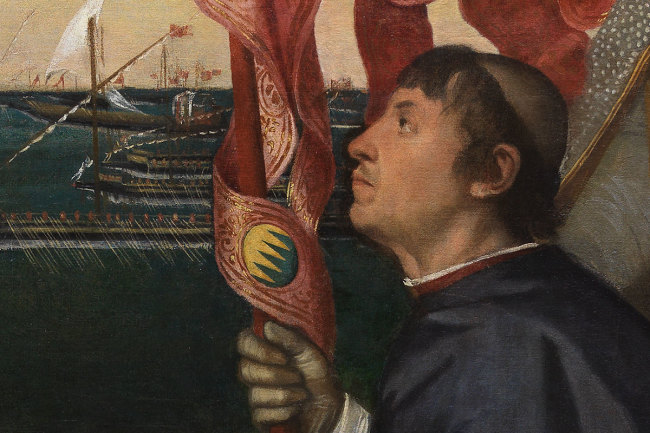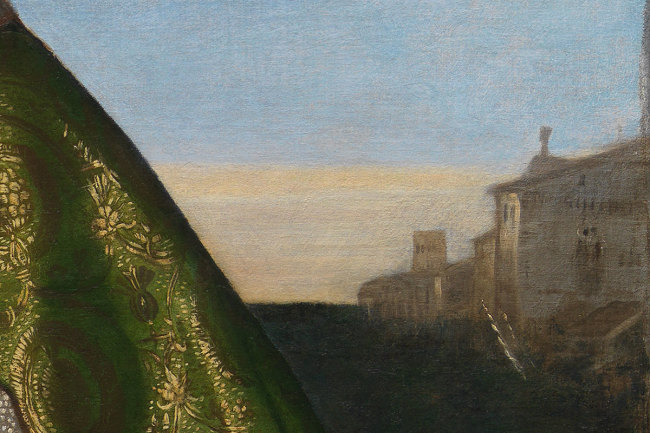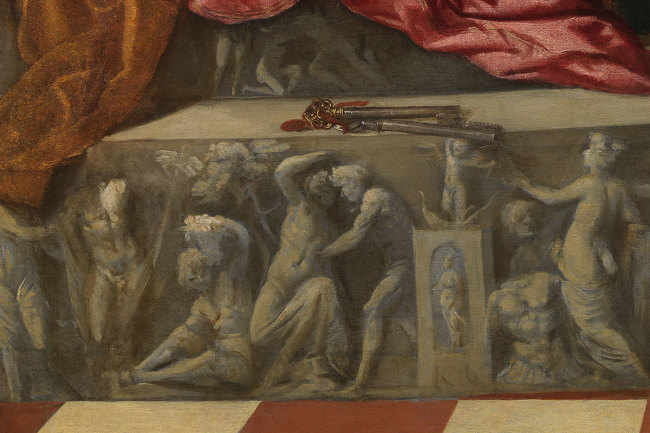How Did Renaissance Artists Make Paint
How to read a Renaissance painting
Published 1 April 2016
Renaissance painters combined technical innovation with a richly symbolic visual language. But what did information technology all hateful? The RA's Lucy Chiswell zooms in on an example from our exhibition In the Age of Giorgione.
-
-
Identify the patron
Working out who commissioned a Renaissance painting – the patron or donor – oftentimes unlocks the primal to its meaning, specially if they make a cameo appearance in the work itself.
This painting was probably painted past Titian (c.1488 – 1576) when he was in his early twenties. Information technology was deputed by Jacopo Pesaro, Bishop of Paphos on the island of Cyprus, which was and so part of the Venetian Democracy. Pesaro was not just a religious figure. He was appointed past militaristic Pope Alexander Vi of the Borgia family to lead the papal fleet confronting the Turks.
Despite the threat of war, an elite class of patrons connected to commission works from of import artists working in Venice, and Titian was repeatedly returned to past Jacopo, who deputed the Pesaro Altarpiece in the church of the Santa Maria Gloriosa dei Frari around a decade later.

Titian, Jacopo Pesaro Existence Presented by Pope Alexander Vi to Saint Peter, 1508–11.
-
-
-
Look out for background clues
Details in a Renaissance painting are rarely accidental. Here, the boats in the groundwork provide valuable clues to unlocking its meaning and placing it geographically.
This painting commemorates Pesaro leading the Venetians to their naval victory over the Turks at the battle of Santa Maura. The young donor is depicted in the heart, flanked by Pope Alexander to the right and Saint Peter to the left.
The boats we see in the background are galleys, the type of vessel used in maritime battles throughout the lengthy Ottoman-Venetian wars that included the Boxing of Lepanto in 1571.

-
-
-
Note the illusion of space
Renaissance painters harnessed the power of perspective to trick the centre into believing the pictorial space was existent.
Compositional harmony is central to painting during the Renaissance. Here, Titian uses chequered paving stones to create linear perspective, giving an illusion of spatial depth. The parallel lines recede into the altitude and converge at what is known as a "vanishing point".
The much older Giovanni Bellini (c. 1430 – 1516), in whose workshop Titian may accept trained, uses this technique in his Virgin and Child with Saint Peter and Saint Mark and a Donor ('Cornbury Park Altarpiece'), which is also in our exhibition. In both instances, a distant mural further enhances the spatial depth of the scene. At the time Titian painted the Pesaro work, landscape was starting to play an of import role for artists in Venice, calculation atmosphere and a poetic quality to the paintings. The buildings on the right - presumably Venetian - exemplify this, Titian handling the paint more loosely as they motion further into the distance.

-
-
-
Look out for hidden geometries
Lines within the painting subtly direct the viewer'due south attention.
Titian pulls the focus of the painting towards the well-nigh important figure: Saint Peter. Strongly aligned parallel lines formed by the backs of the two figures on the right, combined with the slanted standard held past Pesaro and his forrad-leaning stance and angled caput, draw our gaze to the Saint.
Despite this, stability is maintained by the aligned faces of the ii figures, forming the corresponding side of a counterbalanced triangle. Titian too uses the limerick of this scene to prove the hierarchy of the figures: St. Peter is positioned highest and aligned with the heavens, while Pope Alexander Vi acts as a concrete and metaphorical intermediary, bridging the gap between the Saint and the donor, the latter of whom is very much grounded hither on Globe. The variation of the frontal position of Saint Peter, the angled stance of the Pope and Jacopo Pesaro in profile adds rhythm to the scene.

-
-
-
Spot the iconography
They may seem like random objects, but symbols and icons play an important role in telling the story.
Saints are most commonly identified by their attributes in Renaissance painting. Oftentimes these are symbols of their martyrdom, equally can be seen in Giovanni Cariani's St. Agatha, who holds her severed breasts on a platter. Saint Peter, however, is commonly shown in his part as custodian of the gates of Heaven, represented by the keys given to him past Christ. Here, the keys are seen resting precariously on the border of the antique pedestal. Titian paints ane fundamental in gold and 1 in silver, corresponding both in color and design to the papal insignia on the standard held by Pesaro.
The study of classical prototypes was cardinal to artistic training during the Renaissance, and aboriginal Greek and Roman motifs were often quoted in paintings. Titian'south loosely executed antique frieze anticipates the simulation of classical sculpture in his celebrated Sacred and Profane Love in the Galleria Borghese, Rome, a few years after. The iconography of the frieze here is mayhap a comment on the themes of the painting: the central figure of Cupid turns his back on a grouping of figures representing worldly pleasures, which must be relinquished to make style for success.

-
-
-
Accept a close wait at the clothes
Depicting the shapes and textures of clothing in paint was one of the areas in which Renaissance painters demonstrated their mastery.
Titian is historic for his skilled handling of texture. Later works illustrate this, for instance the Vendramin Family in London's National Gallery. Yet early paintings past Titian, such as this work, already show him experimenting with rich and varied materials.
Information technology is interesting to compare the textured sleeves of Pesaro's under-garment with the smooth nature of his black habit – which in itself displays a broad range of black shades. Similarly, Saint Peter's rich ruddy drapery provides a dynamic contrast to the dull brown overlay, while the intricate golden pattern on the Pope's cape is testify of Titian's attention to detail. The potent lite source coming from the left of the painting emphasises the texture, volume and colour of the monumental costumes worn past all three figures. Sixteenth-century biographer Giorgio Vasari famously assembly Venetian painters with honouring colour above all else, aligning disegno – or cartoon – with the fundamental Italian schools of Florence and Rome.

-
-
In the Age of Giorgione is in the Sackler Galleries until 5 June 2016.
Lucy Chiswell is a curatorial banana in the RA Exhibitions department.
Source: https://www.royalacademy.org.uk/article/how-to-read-a-renaissance-painting
Posted by: perkinshathand.blogspot.com


0 Response to "How Did Renaissance Artists Make Paint"
Post a Comment